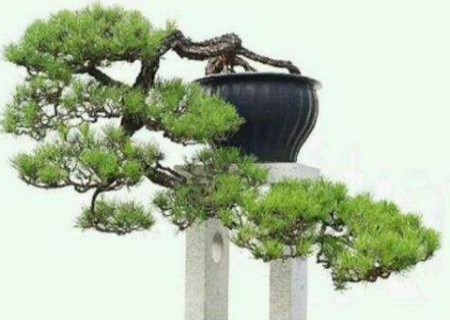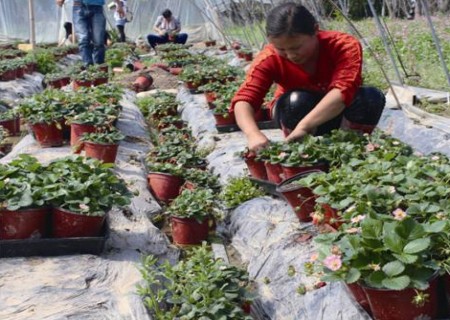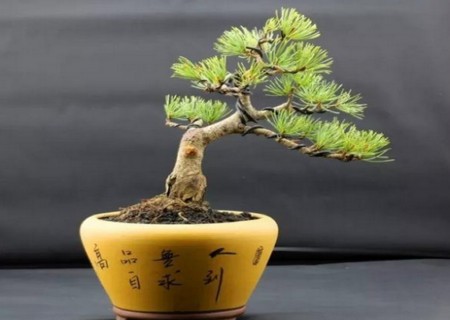Conservation and Management of Mountain Pine Bonsai
Mountain pine, also known as Masson pine, common tree species, can make bonsai material is relatively rare, and slow growth, production and maintenance is difficult, but the tree type is beautiful, can show a variety of artistic conception, so it is more precious.
As bonsai is a living art, its creation has no end, and the process of maintenance and management is the continuation and extension of modeling. For the pine bonsai, the maintenance is reasonable, the longer the time, the more perfect the shape. Pine tree has a long life, pine bonsai is a work handed down from generation to generation, maintenance and management is more important.
Pinus elliottii is resistant to barren, but also likes fertilizer. During the period of pile growth, thin fertilizer should be applied frequently, and fertilizer should be diluted 20 times with cake fertilizer once a month in late spring and early summer and autumn. Using large basin with well-developed root system can appropriately increase the number of fertilization, such as the conditional application of retting shellfish fertilizer or fish fertilizer, promoting strength is the most effective, high-quality high-efficiency particle compound fertilizer with good quality should be used cautiously. Generally do not apply nitrogen fertilizer such as urea or human feces and urine, because pine needles can absorb nitrogen in the air, and pine roots are very sensitive to nitrogen.

It is not suitable to apply fertilizer in midsummer, severe winter and rainy days, and it is most suitable to apply liquid fertilizer when the soil is dry in the afternoon. Watering again after application is convenient for root absorption. Mountain pine must not apply raw fertilizer, raw fertilizer to burn roots, too much fertilizer will make the needles grow and hurt the roots until the sap reverses and causes the plant to lose water and wither.
As the saying goes, "dry pine and wet cypress", mountain pine is afraid of waterlogging and wet water, and likes to be dry, but it is not as dry as it gets. In fact, as long as the soil is loose and the bottom layer is hydrophobic, the soil should always be kept moist. During the high temperature period in summer, water thoroughly every morning and evening to avoid midday watering to burn stuffy roots, and efforts should be made to avoid potted side exposure to burn the roots. Other seasons depend on the weather. It can be watered every three or four days in winter, but it must be drenched thoroughly.
Mountain pine maintenance is actually relatively extensive, not as difficult as imagined. Mountain pine on the basin can be turned once every three or four years. In fact, as long as the basin soil is hydrophobic, the basin size is moderate, the fertilizer and water is proper, and it still shoots year after year without turning the basin for three, five or even ten or eight years, and grows well, we only need to pay attention to the prevention and control of diseases and insect pests, cut off the branches of diseases and insect pests, withered branches, over-dense branches, etc., and if we find that the growth of the plant is weakened, we must check the reasons. Turn the basin to change the soil or replant the large basin at any time.
The normal time of turning the basin should be carried out in late autumn or early spring. Turning the basin can first control the water to make the basin soil dry, separate the basin soil from the basin wall, then pour the plant out of the basin, trim the bottom and all around the aging roots, cut off the withered roots and rotten roots, and remove the persistent soil in the middle of the mud mass, as long as it does not hurt the roots, remove as much as it can. At the same time, trim some branches and leaves, maintain growth balance, and replace it with new soil, insert floating soil around bamboo slices, and then pour water through it, so that it can grow normally after half a month.
Maintenance management is the continuous extension of modeling, and conformal shaping or modification is an important part of the maintenance and management of mountain pine bonsai. The first is to continue to adjust the tree shape with the thickening of branches, and the second is to continue to press buds, thinning buds, thinning branches and controlling needles, not only to maintain the tree shape but also to fine-tune the tree shape to strengthen the consciousness of fine products and strive for excellence. Control the second germination once a year, cut in time before the needles fall off, prevent loose shape, make sure that the tree shape is compact, lateral branches are richer and more reasonable, and the plant shape is more perfect.
Mountain pine has strong disease resistance and few diseases and insect pests, mainly longicorn beetles, pine aphids, pine scale, leaf blight, rust and so on. The harm of longicorn beetles is mostly in early summer, and can be observed sooner or later to kill adults. If it is found that there is salivary mucus in the branches, it must be recently drilled to lay eggs, or if you see sawdust at the mouth of the hole, larvae have been drilled, and larvae can be smothered with omethoate and dichlorvos. Leaf blight and pine needle rust can be controlled with drugs such as topzine and carbendazim, and other diseases and pests can be controlled with corresponding conventional pesticides.
In the process of maintenance, attention should be paid to:
Experience 1: taking a good soil mass and not watering it are two key links. Don't step and dig if you can't take a good lump of dirt.
Lesson 2: when transplanting mountain pine piles, you must bring soil blocks, and the soil blocks cannot be loosened. The bigger the soil blocks, the easier it is to survive. Of course, you must be able to carry them. For a large pile, it is best to break the lateral root first and dig again the following year after copying the soil. Useless branches should be resolutely gone, never nostalgia, in order to facilitate the parallel of water. Of course, you should also drench enough water to keep the soil moist.
Time: 2019-05-31 Click:
- Prev

How to weed strawberry planting
Preventing weeds has always been an important problem in strawberry production. Due to the large amount of fertilizer application, frequent irrigation and large number of weeds in strawberry orchard, it not only competes with strawberry for water and nutrients, but also affects ventilation and light transmission, worsens the microclimate of strawberry orchard and causes serious diseases and insect pests. Grass damage can cause yield loss of about 15%.
- Next

What about the yellow leaves of mountain pine bonsai?
Mountain pine is deeply loved by people because of its rugged and simple tree stalks and its green evergreen posture. But everyone may have such an experience, in a piece of green flowers and trees, there are one or more yellowed pine leaves, it appears to be very eye-catching, very incongruous. Why under the same natural conditions and the same mode of management
Related
- Fuxing push coffee new agricultural production and marketing class: lack of small-scale processing plants
- Jujube rice field leisure farm deep ploughing Yilan for five years to create a space for organic food and play
- Nongyu Farm-A trial of organic papaya for brave women with advanced technology
- Four points for attention in the prevention and control of diseases and insect pests of edible fungi
- How to add nutrient solution to Edible Fungi
- Is there any good way to control edible fungus mites?
- Open Inoculation Technology of Edible Fungi
- Is there any clever way to use fertilizer for edible fungus in winter?
- What agents are used to kill the pathogens of edible fungi in the mushroom shed?
- Rapid drying of Edible Fungi

